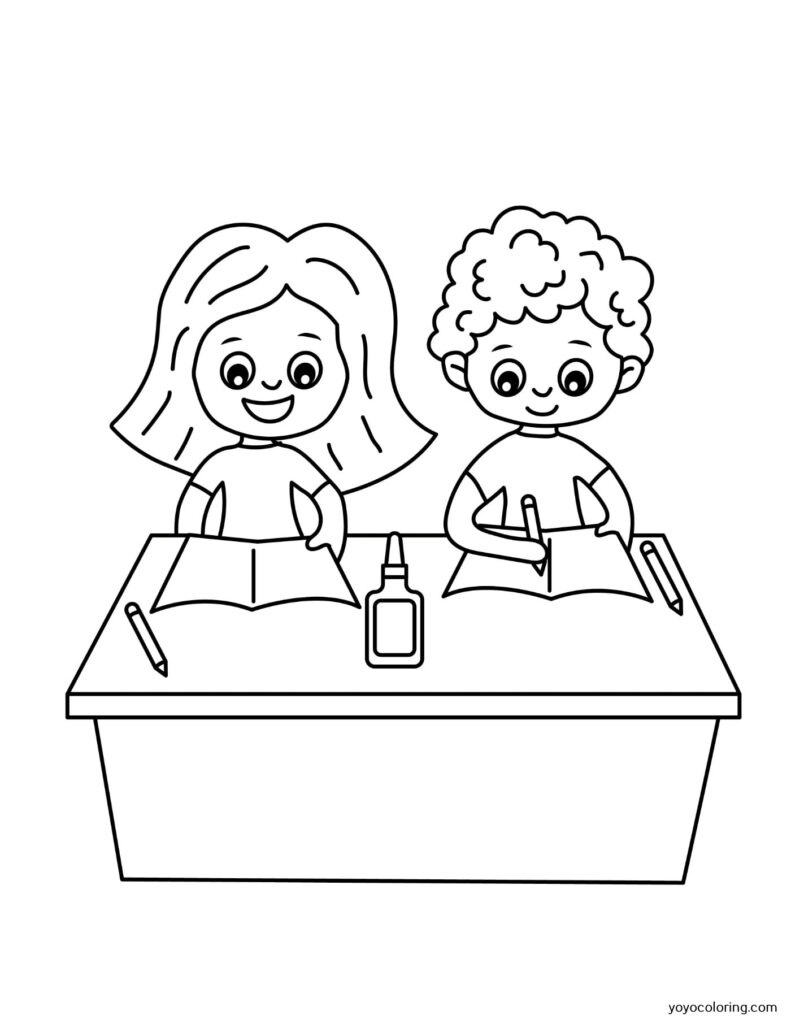Life in the classroom can sometimes feel routine, and as a teacher, I’m always on the lookout for fresh and engaging ways to keep my students interested. That’s when classroom coloring pages come in handy – they’re not only fun, but they offer countless learning opportunities too! I’ve found that they’re a fabulous way to encourage creativity and collaboration among students, all while reinforcing important concepts in a visually meaningful way.
Having coloring pages in the classroom serves multiple purposes, and it’s a versatile tool every teacher should consider adding to their arsenal. These printable worksheets can be used to teach new concepts, review previous lessons, or even as a calming activity during breaks. I also love using them as an extension activity – after explaining a topic, I’ll have my students color in the relevant pages, allowing them to continue exploring the idea through an artistic lens.
But you might wonder, do classroom coloring pages really hold up as a worthwhile learning tool? Absolutely! In fact, researchers have found that coloring helps improve focus, develop fine motor skills, and can even reduce stress levels. So, if you’re looking to add some COLOR to your lesson plans, I’d say giving classroom coloring pages a try is a win-win situation for both you and your students.
The Benefits of Classroom Coloring Pages
I’ve always loved coloring, and it turns out it’s not just a fun hobby for kids – it offers numerous benefits in the classroom as well! Let me tell you about some of the key advantages of incorporating classroom coloring pages into your lesson plans.
First and foremost, coloring can help improve focus and concentration. Students, especially younger ones, might find it hard to stay on task during a lecture or a reading-heavy lesson. Coloring pages can be a great way to engage their minds, helping them stay active and attentive without causing too much distraction.
Another fantastic benefit of coloring is its ability to enhance fine motor skills. When children hold crayons and color within the lines, they’re developing their hand-eye coordination and grip control. These abilities not only help with coloring but can also translate to everyday activities, such as writing and tying shoelaces.
One of my favorite things about coloring pages is that they give students the opportunity to express creativity. I firmly believe that all children have an innate creative spark, and coloring can help them explore it. Plus, allowing students to choose colors and create something uniquely theirs adds a sense of ownership and accomplishment to their work.
Additionally, classroom coloring pages provide a low-pressure way to practice learning concepts. For example, imagine coloring pages that feature different shapes, numbers, or letters. By connecting students’ enjoyment of coloring with these educational elements, you can create a fun, memorable learning experience for them.
Let’s not forget about the social and emotional benefits as well. Coloring can be a calming and de-stressing activity, which is incredibly valuable in today’s fast-paced classrooms. Students can take a break from academic and social pressures while focusing on a simple yet fulfilling task.
Here’s a quick recap of the benefits that classroom coloring pages offer:
- Improved focus and concentration
- Enhanced fine motor skills
- Creative expression
- Low-pressure learning practice
- Social and emotional growth
Don’t shy away from experimenting with coloring pages in your lessons if you’re looking for a fun, engaging, and beneficial activity to boost your students’ learning experience.
How to Choose the Perfect Classroom Coloring Pages
Selecting the perfect classroom coloring pages, might seem like a daunting task, but it doesn’t have to be! I’ve got some tips to help simplify the process while still making sure you’re getting the best coloring pages for your students.
- Focus on age-appropriateness: First and foremost, consider the age of your students. Giving elementary school students detailed, intricate coloring pages intended for adults will only frustrate them. Likewise, teens might not be very engaged with coloring pages meant for toddlers. Stick to what’s suitable for their age group, and you’ll have higher chances of keeping them happily entertained.
- Relate to the subject matter: Having coloring pages that align with what you’re teaching in class can go a long way in making the coloring activity more meaningful. Not only will this help to reinforce the subject matter, but it can also make for a fun way to review what they’ve learned.
- Variety is key: Just like with any activity, providing a variety of coloring pages with different themes, complexity levels, and subject matters is crucial to keeping students engaged. Try incorporating a mix of:
- Animals
- Scenery
- Cars and trucks
- Holidays
- Abstract patterns The more variety, the better the chance of appealing to every student’s interests!
- Consider student preferences: Take the time to get to know your students’ preferences. Some might enjoy coloring animals, while others may be into drawing their favorite cartoon characters. Use their input to not only add variety to the coloring pages lineup but also to make them feel their interests matter.
- Opt for customizable pages: Another helpful tip is to invest in customizable coloring pages, like those that allow you to add your own text or graphics. That way, you can create personalized pages that relate to your lesson plans, unique classroom themes, or even specific students.
In the end, the best classroom coloring pages will depend on the specific needs and tastes of your students. By considering their ages, preferences, and the subject matter being taught, you’ll be well on your way to offering engaging and effective coloring activities for everyone! Remember to keep it fun, age-appropriate, and varied – and don’t forget to get creative with customizations!
Integrating Classroom Coloring Pages into Lesson Plans
When I think of ways to add some creativity and fun to my lesson plans, one idea that comes to mind is integrating classroom coloring pages. They’re not just for preschoolers; coloring pages can offer value to students of all age groups. Let me walk you through how I integrate these into my lessons to engage my students better and enhance their learning experiences.
The first thing I consider is the subject matter at hand. Coloring pages can be helpful in visual subjects like history, geography, and science. For instance, to teach a lesson on American history, including coloring pages with images depicting important events or figures allows students to have a hands-on, visual learning experience. Similarly, for a geography lesson, coloring in different countries’ flags or state boundaries provides students with a clearer understanding of the material covered.
Here are some ways I incorporate coloring pages to address various learning styles:
- Kinesthetic learners: They benefit from hands-on activities. Coloring pages give them the opportunity to interact physically with the subject content, aiding retention of information.
- Visual learners: Coloring aids in information visualization, letting them associate images with facts.
- Auditory learners: Incorporating a verbal component during the coloring activity helps, such as discussing facts and asking questions while students are coloring.
Another aspect to keep in mind is modifying coloring pages for different age groups. Adapting the complexity of the images and the coloring activities to suit the learners’ ages is essential for effective engagement.
Here are some suggestions for age-appropriate coloring page activities:
| Age group | Activity description |
|---|---|
| Kindergarten – 2nd grade | Simple images with large, easily distinguishable sections, and focus on basic topics. |
| 3rd grade – 5th grade | More detailed images, introduction of relevant labels, and additional elements for information association. |
| Middle school and above | Detailed, realistic images with accompanying captions, maps, and timelines. Encourage students to color code specific information to enhance learning. |
Lastly, I like to incorporate technology to make coloring pages more interactive. I often suggest that students use digital tools like tablets and stylus pens to color on-screen. This allows for easy sharing, collaboration, and instant feedback.
Incorporating classroom coloring pages into lesson plans not only makes learning more enjoyable but also engages learners in different ways. Give it a try, and enjoy watching your students’ creativity and learning abilities flourish!
Printable vs. Online Coloring Pages for the Classroom
When it comes to incorporating coloring pages in the classroom, I often hear teachers and parents debating the merits of printable vs. online options. I felt it would be helpful to discuss the pros and cons of each, so you can make an informed decision for your classroom.
Printable coloring pages offer a variety of benefits for both teachers and their students:
- Tactile experience: There’s just something about holding a crayon, marker, or colored pencil that helps engage kids in the creative process. Coloring on paper provides that important hands-on experience.
- Portability: Printable pages can be taken anywhere, making them great for students who are on the go or who have limited access to technology.
- Teaching tool: Teachers can use printable coloring pages to illustrate specific concepts, which can be particularly helpful for younger students who are visual learners.
However, there are some downsides to using printable pages:
- Cost: Purchasing coloring books or printing pages from online sources can add up, especially if you’re providing materials for an entire class.
- Environmental impact: The use of paper, ink, and energy to print coloring pages can take a toll on the planet.
On the other hand, online coloring pages have their own set of advantages:
- Accessibility: Online options can be easily accessed from any device with an internet connection. This means students can color during computer lab sessions or even at home during remote learning.
- Customization: Many online coloring platforms allow for adding text or using custom colors, which can make for more personalized and engaging learning experiences.
- Eco-friendly: With no printing required, online coloring pages don’t contribute to paper waste, thus making it a more environmentally friendly choice.
But, as with any technology-based option, there are drawbacks:
- Lack of tactile experience: While some kids adapt easily to digital coloring, others may struggle and miss the physical connection that comes with using art materials.
- Reliability: Access to online coloring pages relies on a stable internet connection, which may not always be available or consistent.
| Pros | Cons |
|---|---|
| Tactile experience (printable) | Cost (printable) |
| Portability (printable) | Environmental impact (printable) |
| Teaching tool (printable) | Lack of tactile experience (online) |
| Accessibility (online) | Reliability (online) |
| Customization (online) | |
| Eco-friendly (online) |
Given these pros and cons, the choice between printable and online coloring pages really comes down to the specific needs of your classroom and students. By evaluating factors such as engagement, accessibility, and cost, you can determine which option will best serve your learners. And don’t forget that sometimes, a mix of both can provide the most comprehensive and rewarding experience.
Different Categories of Classroom Coloring Pages
When it comes to classroom coloring pages, there’s a wide array of categories to choose from. In this section, I’ll walk you through some of the most popular types of classroom coloring pages that I’ve come across, which are perfect for engaging young students and helping them learn new concepts.
Alphabet and Numbers: These coloring pages often feature letters and numbers, making it fun for children to learn the basics. By coloring in each letter or number, they’re more likely to remember them and associate colors with their shapes.
- Examples: A is for Apple, B is for Ball, and 1 is for One Flower
Shapes and Patterns: This category helps kids recognize different shapes and patterns by having them color in each shape according to the instructions provided. This can improve their spatial awareness and understanding of geometric concepts.
- Examples: Circle, Square, Triangle, and Star
Animals and Nature: These coloring pages showcase various animals, plants, and natural landscapes. Coloring these pages can help broaden children’s understanding of the natural world and encourage their curiosity about living beings.
- Examples: Elephants, Fish, Trees, and Butterflies
Culture and Holidays: Coloring pages related to culture and holidays can teach children about different traditions and customs. It’s a great way to introduce new information and create a sense of empathy toward other cultures.
- Examples: Christmas, Hanukkah, Diwali, and Chinese New Year
Characters and Stories: Characters from books, movies, and TV shows can make academics more relatable and enjoyable. By incorporating popular characters, teachers can better engage with kids and make learning more memorable.
- Examples: Disney Characters, Superheroes, and Cartoon Animals
Educational Topics: This category combines learning with creativity. These coloring pages might include science concepts (like the solar system or the water cycle), historical events, or even famous people. They can help children visualize complex topics while having fun.
- Examples: Famous Inventors, The Food Pyramid, and The Life Cycle of a Butterfly
In my experience, diversifying the types of classroom coloring pages you use can keep students engaged and excited about learning. It’s essential to adapt your selection to the interests and needs of your students, encouraging a love for learning and creativity.
Conclusion
Well, we’ve reached the end of our journey exploring classroom coloring pages. I’ve thoroughly enjoyed sharing my thoughts and experiences with you, and I hope you’ve found this information useful. Let’s recap what we’ve covered in the previous sections:
- Benefits of using coloring pages in the classroom
- Different types of classroom coloring pages
- Ideas for incorporating coloring pages into various subjects
- How to select appropriate coloring pages
- Where to find resources and inspiration for classroom coloring pages
I believe that coloring pages can be an excellent resource for educators, as they can provide both educational and emotional benefits. Students can develop their creativity, fine motor skills, and focus while enjoying some quiet moments. Additionally, coloring pages can be integrated into any subject, making them versatile tools for reinforcing concepts or introducing new topics.
Keep in mind a few important considerations:
- Strike a balance between education and entertainment
- Be aware of the difficulty level
- Choose coloring pages that suit the age and skill level of your students
- Encourage students to explore and express themselves through coloring, but also ensure they understand the learning objectives
Some ways to use coloring pages effectively include:
- Incorporating into lesson plans
- Using as a tool for relaxation and stress relief
- Connecting with seasonal topics and holidays
- Utilizing for early finishers and group activities
There is a multitude of resources available online, including printable worksheets, digital coloring apps, and free educational websites. Remember, when selecting coloring pages for your classroom, always ensure that they align with your teaching goals.
In closing, it’s been a pleasure discussing the ins and outs of classroom coloring pages, and I hope you’re inspired to add these creative resources to your teaching toolbox. I wish you the best of luck engaging your students with these fun and educational activities!





